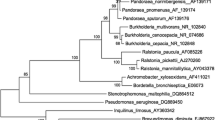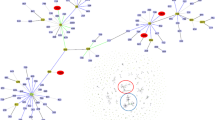Abstract
Burkholderia cepacia, Stenotrophomonas maltophilia, andAlcaligenes xylosoxidans have been isolated with increasing frequency from the sputum of patients with cystic fibrosis in a pediatric hospital. In 1994–95, 27 of 120 patients were persistently colonized, 17 withBurkholderia cepacia, eight withAlcaligenes xylosoxidans, and five withStenotrophomonas maltophilia. Genotyping of 220 clinical isolates revealed that most of theBurkholderia cepacia strains were clonally related, suggesting either cross-infection or a common source of exposure. In contrast, neither crossinfection nor a common source of exposure appear to have occurred in the cases ofAlcaligenes xylosoxidans orStenotrophomonas maltophilia.
Similar content being viewed by others
References
Steinbach S, Sun L, Jiang RZ, Flume P, Gilligan P, Egan TM, Goldstein R: Transmissibility ofPseudomonas cepacia infection in clinic patients and lung-transplant recipients with cystic fibrosis. New England Journal of Medicine 1994, 331: 981–987.
Lipuma JJ, Dasen SE, Nielson DW, Stern RC, Stull TL: Person-to-person transmission ofPseudomonas cepacia between patients with cystic fibrosis. Lancet 1990, 336: 1094–1096.
Govan JRW, Brown PH, Maddison J, Doherty CJ, Nelson JW, Dodd M, Greening AP, Webb AK: Evidence for transmission ofPseudomonas cepacia by social contact in cystic fibrosis. Lancet 1993, 342: 15–19.
Klinger JD, Thomassen MJ: Occurrence and antimicrobial susceptibility of gram-negative nonfermentative bacilli in cystic fibrosis patients. Diagnostic Microbiology and Infectious Disease 1985, 3: 149–158.
Valcin M, Moissenet D, Sardet A, Tournier G, Garbarg-Chenon A, Vu-Thien H:Pseudomonas (Burkholderia) cepacia in children with cystic fibrosis: epidemiological investigation by analysis of restriction fragment length polymorphism. Pathologie Biologie 1996, 44: 442–446.
Tenover FC, Arbeit RD, Goering RV, Mickelsen PA, Murray BE, Persing DH, Swaminathan B: Interpreting chromosomal DNA restriction patterns produced by pulsed-field gel electrophoresis: criteria for bacterial strain typing. Journal of Clinical Microbiology 1995, 33: 2233–2239.
Lipuma JJ, Mortensen JE, Dasen SE, Edlind TD, Schidlow DV, Burns JL, Stull TL: Ribotype analysis ofPseudomonas cepacia from cystic fibrosis treatment centers. Journal of Pediatrics 1988, 113: 859–862.
Fisher MC, Lipuma JJ, Dasen SE, Caputo GC, Mortensen JE, McGowan KE, Stull TL: Source ofPseudomonas cepacia: ribotyping of isolates from patients and from the environment. Journal of Pediatrics 1993, 123: 745–747.
Larsen GY, Stull TL, Burns JL: Marked phenotypic variability inPseudomonas cepacia isolated from a patient with cystic fibrosis. Journal of Clinical Microbiology 1993, 31: 788–792.
Bingen E, Weber M, Derelle J, Brahimi N, Lambert-Zechovsky N, Vidailhet M, Navarro J, Elion J: Arbitrarily primed polymerase chain reaction as a rapid method to differentiate crossed from independentPseudomonas cepacia infections in cystic fibrosis patients. Journal of Clinical Microbiology 1993, 31: 2589–2593.
Dunne WM Jr, Maisch S: Epidemiological investigation of infections due toAlcaligenes species in children and patients with cystic fibrosis: use of repetitive-elementsequence polymerase chain reaction. Clinical Infectious Diseases 1995, 20: 836–841.
Cheron M, Abachin E, Guerot E, El-Bez M, Simonet M: Investigation of hospital-acquired infections due toAlcaligenes denitrificans subsp.xylosoxidans by DNA restriction fragment length polymorphism. Journal of Clinical Microbiology 1994, 32: 1023–1026.
Mortensen JE, Fisher MC, Lipuma JJ: Recovery ofPseudomonas cepacia and otherPseudomonas species from the environment. Infection Control and Hospital Epidemiology 1995, 16: 30–32.
Author information
Authors and Affiliations
Rights and permissions
About this article
Cite this article
Vu-Thien, H., Moissenet, D., Valcin, M. et al. Molecular epidemiology ofBurkholderia cepacia, Stenotrophomonas maltophilia, andAlcaligenes xylosoxidans in a cystic fibrosis center. Eur. J. Clin. Microbiol. Infect. Dis. 15, 876–879 (1996). https://doi.org/10.1007/BF01691221
Issue Date:
DOI: https://doi.org/10.1007/BF01691221




